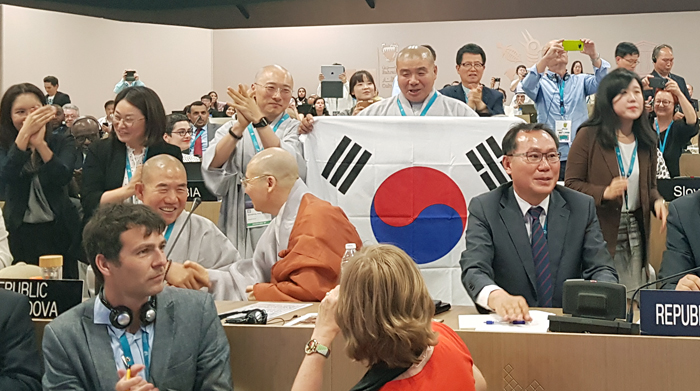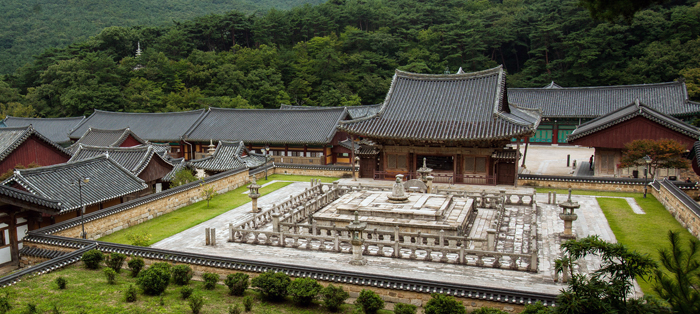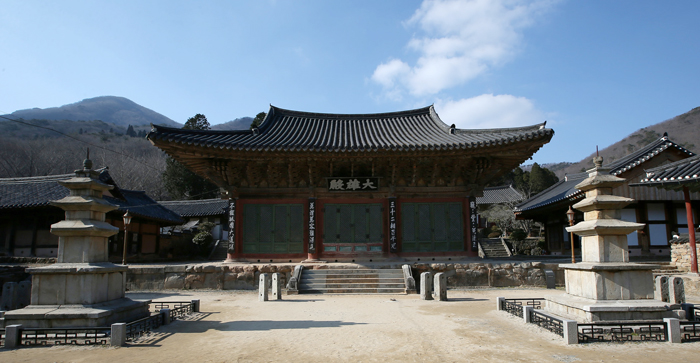
The Korean delegation celebrates as seven sansa Buddhist mountain monasteries get inscribed on UNESCO's list of World Heritage sites, during the 42nd meeting of the World Heritage Committee held in Manama on June 30. (Cultural Heritage Administration)
By Kang Gahui and Kim Young Shin
A network of sansa Buddhist mountain temples located across Korea's southern provinces has been added to the UNESCO list of World Heritage sites. This is now the 13th Korean item or site inscribed on the list.
The World Heritage Committee (WHC) held its 42nd session in Manama, Bahrain, on June 30 and announced the new addition saying, “The spatial arrangement of the seven temples that comprise the site, established between the 7th and 9th centuries, present common characteristics that are specific to Korea – the madang open courtyard flanked by four buildings, the Buddha Hall, a pavilion, a lecture hall and a dormitory.”
These seven temples are Tongdosa Temple (통도사) in Yangsan, Gyeongsangnam-do Province, Buseoksa Temple (부석사) in Yeongju, Bongjeongsa (봉정사) in Andong, Gyeongsangbuk-do Province, Beopjusa Temple (법주사) in Boeun-gun, Chungcheongbuk-do Province, Magoksa Temple (마곡사) in Gongju, Chungcheongnam-do Province, Seonamsa Temple (선암사) in Suncheon and Daeheungsa Temple (대흥사) in Haenam, Jeollanam-do Province.
The International Council on Monuments and Sites, an advisory body, recommended the committee to inscribe only four mountain monasteries -- Tongdosa, Buseoksa, Beopjusa and Daeheungsa --despite their "outstanding universal values" because the conditions of integrity of the individual components had not been met, the body said.
However, all seven ended up being listed as UNESCO World Heritage sites after China, a member of the WHC, proposed that all seven temples be inscribed. The agreement was signed by 17 out of 21 states parties and was supported by 20 countries.
"The Sansa, Buddhist Mountain Monasteries" are now the 13th UNESCO World Heritage item or site in Korea. The previous 12 are: Seokguram Grotto and Bulguksa Temple, and Haeinsa Temple Janggyepng Panjeom, the Depositories for the Tripitaka Koreana Woodblocks listed in 1995, Changdeokgung Palace Complex and Hwaseong Fortress, 1997, Gochang Hwasun, and Ganghwa Dolmen Sites and Gyeongju Historic Areas, 2000, Jeju Volcanic Island and Lava Tubes, 2007, Royal Tombs of the Joseon Dynasty, 2009, Historic Villages of Korea: Hahoe and Yangdong, 2010, Namhansanseong Fortress, 2014, and Baekje Historic areas, 2015.

Tongdosa Temple in Yangsan, Gyeongsangnam-do Province, enshrines a sarira, the cremated remains of the Buddha, in one of its pagodas. (Cultural Heritage Administration)

Seonamsa Temple in Suncheon, Jeollanam-do Province, is one of the seven mountain monasteries newly inscribed on the UNESCO World Heritage list on June 30. (Jeon Han)
kgh89@korea.kr